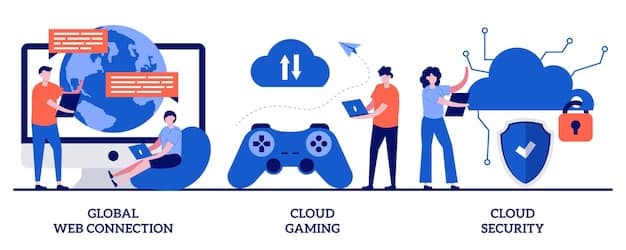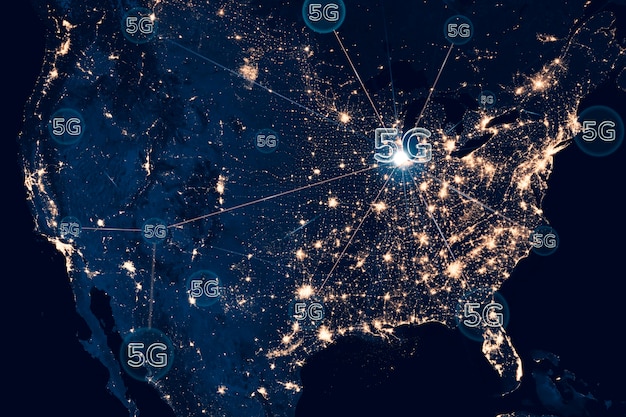Cloud Gaming on Consoles: Replace Downloads by 2026?

The future of cloud gaming on consoles, and whether it will replace traditional downloads for US gamers by 2026, presents a complex interplay of technological readiness, infrastructure development, and consumer adoption, making a complete replacement by then unlikely but significant growth in cloud services inevitable.
The landscape of video games is in constant flux, evolving from physical cartridges to digital downloads, and now, increasingly, towards streaming. This shift raises a pivotal question for US gamers: the future of cloud gaming on consoles: will it replace traditional downloads for US gamers by 2026? It’s a complex query, touching upon technological advancements, consumer behavior, and the underlying infrastructure that powers our digital lives.
The rise of cloud gaming: setting the stage
The concept of cloud gaming, where games are processed on remote servers and streamed to a user’s device, isn’t new. However, its widespread adoption has been hampered by technological hurdles. For years, the promise of playing high-fidelity games without powerful local hardware remained an elusive dream for many.
Recent advancements, particularly in network infrastructure and streaming compression, have brought this dream closer to reality. Major players like Microsoft’s Xbox Cloud Gaming, Sony’s PlayStation Plus Premium, and Nvidia’s GeForce NOW have made significant strides, offering libraries of games accessible on various devices, including, critically, consoles. This push indicates a clear industry direction towards making games more accessible, breaking free from the constraints of powerful local hardware and lengthy download times.
Technological leaps and infrastructure challenges
The core of cloud gaming relies on reliable, low-latency internet connections. For US gamers, this means the expansion of broadband and 5G networks is paramount.
- Broadband penetration: While urban areas generally enjoy robust internet, rural parts of the US still face connectivity issues, posing a significant hurdle for widespread cloud gaming adoption.
- 5G deployment: The rollout of 5G promises faster speeds and lower latency, which are ideal for cloud gaming. However, its full potential and ubiquitous availability are still several years away.
- Server proximity: The physical distance between a gamer and the cloud server affects latency. Major cloud providers are investing in more localized server farms to mitigate this.
Overcoming these infrastructure challenges is not merely a matter of technological capability but also economic investment and regulatory support. Until a significant majority of US households have access to consistently high-speed, low-latency internet, cloud gaming’s ability to completely supplant traditional downloads will be limited.
The seamless experience promised by cloud gaming is dependent on a delicate balance of bandwidth, latency, and server processing power. Even moments of network instability can result in noticeable input lag or degraded graphical quality, frustrating users accustomed to the consistent performance of locally installed games. As technology continues its relentless march, these issues are steadily diminishing, but a perfect, lag-free experience across all conditions remains an ambitious target.
The investment required for building a truly robust cloud gaming infrastructure is immense, involving not just data centers but also the global network backbone. This ongoing, multi-billion-dollar endeavor points to the industry’s long-term commitment, yet it also highlights the scale of the challenge in achieving nationwide, consistent service quality.
Console manufacturers and their cloud strategies
Each of the major console manufacturers has approached cloud gaming with varying degrees of enthusiasm and strategic focus. Their existing ecosystems, game libraries, and business models heavily influence their cloud gaming ambitions.
Microsoft has been a vocal proponent of cloud gaming with Xbox Cloud Gaming, integrating it deeply into their Game Pass Ultimate subscription. This strategy allows subscribers to play a vast library of games on various devices, including tablets, phones, and PCs, thereby expanding the reach of the Xbox ecosystem beyond its console hardware. For Microsoft, cloud gaming is a key part of their “Xbox everywhere” vision, aiming to make gaming accessible to anyone, regardless of owning an Xbox console.
Sony’s evolving approach
Sony’s journey into cloud gaming began earlier with PlayStation Now, which has since been integrated into PlayStation Plus Premium. While offering a selection of PS4, PS3, and classic PS1/PS2 titles via streaming, Sony’s primary focus remains on the PlayStation console experience.
- Legacy game access: Cloud streaming provides a way to play older titles not natively supported on newer consoles.
- Supplement, not replacement: For Sony, cloud gaming appears to be more of a supplementary feature for its premium subscription tiers rather than a core strategy to entirely shift away from console-based gaming.
- Focus on exclusives: PlayStation’s strength lies in its exclusive first-party titles, which often drive console sales.
Sony’s strategy seems to acknowledge the potential of cloud while still heavily banking on the success of its dedicated hardware and the traditional console experience cultivated over decades. The quality and accessibility of their cloud streaming service have improved, but it’s positioned as an added value rather than a disruptive force to their download model.
Nintendo, in contrast, has adopted a more cautious, selective approach, primarily offering cloud versions of certain third-party games that are too graphically intensive for the Switch’s hardware. This pragmatic approach allows them to offer a broader library of titles without compromising their portable-first identity. They haven’t heavily invested in a proprietary cloud gaming service akin to Microsoft or Sony, suggesting a preference for localized gameplay where possible.
The differing strategies reflect each company’s unique market position and long-term vision. Microsoft is pushing boundaries, Sony is cautiously expanding, and Nintendo is selectively adapting. These varied approaches will profoundly impact how and when cloud gaming becomes a ubiquitous part of the console gaming experience in the US.
Consumer perspective: adoption and resistance
The ultimate success of cloud gaming, and its potential to replace traditional downloads, rests squarely on consumer adoption. Gamers, especially those in the US, are accustomed to a certain level of performance, ownership, and accessibility that traditional downloads provide.
For many, the appeal of cloud gaming lies in its convenience. No lengthy downloads, no storage concerns, and the ability to play high-end games on less powerful devices are significant advantages. This is particularly attractive to casual gamers or those who don’t want to invest in expensive hardware upgrades.
Challenges to widespread adoption
Despite the benefits, several factors create resistance to fully embracing cloud gaming.
- Internet dependency: A stable, high-speed internet connection is not universal across the US. Drops, spikes, or overall limited bandwidth can severely degrade the cloud gaming experience.
- Perceived ownership: Gamers often prefer to “own” their games, even in digital form. The idea of merely renting access to a game via streaming can be a deterrent.
- Input lag and visual quality: While improving, cloud gaming can still introduce slight input lag and compression artifacts, noticeable to discerning players.
- Subscription fatigue: With numerous streaming services vying for consumer dollars, adding another gaming subscription might face resistance.
Gamers have a strong emotional connection to their libraries and the tactile experience of gaming on their console. The shift from a local, owned experience to a streamed service requires a significant mental adjustment for many. The joy of instantly launching a downloaded game, free from network variables, is a powerful draw that cloud gaming still struggles to fully replicate for all use cases.
Furthermore, the business model of cloud gaming, often tied to a subscription, differs fundamentally from purchasing games outright. While subscriptions offer access to a vast library, they also imply a recurring cost and a lack of permanent ownership, which can be a psychological barrier for some consumers.
Infrastructure and economic factors
The technical and strategic aspects of cloud gaming are underpinned by substantial infrastructure and economic considerations. The sheer scale required to deliver a high-quality streaming experience to millions of US gamers is immense, and the return on investment isn’t always immediate.
Building and maintaining data centers, upgrading network infrastructure, and ensuring low latency across a vast geographical area like the US requires continuous, multi-billion-dollar investments. Companies like Google Stadia learned this lesson the hard way, eventually shutting down their service despite significant investment, highlighting the competitive and costly nature of this market.
The economics of data and bandwidth
Delivering high-fidelity game streams consumes significant bandwidth, both for the end-user and for the cloud provider.
- ISP data caps: Many US internet service providers (ISPs) impose data caps. Frequent, high-resolution cloud gaming sessions could quickly consume these allowances, leading to overage charges or throttled speeds.
- Server costs: Cloud providers incur massive operational costs for servers, power, cooling, and maintenance. These costs must be offset by subscription revenues or other business models.
- Content licensing: Securing the rights to stream a vast library of games involves complex and often expensive licensing agreements with game publishers and developers.
The pricing models for cloud gaming services must strike a balance between affordability for consumers and profitability for providers. If the cost is too high, adoption will lag; if too low, the service may be unsustainable in the long run. This delicate balance is a crucial economic factor in the widespread proliferation of cloud gaming.
Moreover, the energy consumption of large-scale data centers raises environmental concerns, pushing providers to innovate in efficiency and renewable energy sources. This adds another layer of complexity and cost to the overall cloud gaming ecosystem. The economic viability of cloud gaming is not just about bringing in revenue but also about managing extraordinarily high operational expenditures.
The role of internet service providers and 5G
The backbone of effective cloud gaming is the internet. In the US, the landscape of Internet Service Providers (ISPs) and the ongoing rollout of 5G technology play a critical role in determining cloud gaming’s future.
While major metropolitan areas in the US generally benefit from robust fiber optic and cable internet infrastructure, significant disparities exist. Rural and underserved areas often rely on slower, less reliable connections, making a high-quality cloud gaming experience challenging, if not impossible. The “digital divide” is a real barrier to universal cloud gaming adoption.
5G: a potential game-changer?
The promise of 5G is transformative for many aspects of digital life, and cloud gaming is high on that list.
- Lower latency: 5G networks are designed with significantly lower latency than previous generations, crucial for reducing input lag in cloud gaming.
- Higher bandwidth: Increased speeds mean higher quality streams (e.g., 4K resolution) are more feasible, even on mobile connections.
- Mobile cloud gaming: 5G could enable a true console-quality gaming experience on mobile devices without needing a strong Wi-Fi connection, greatly expanding where and how people play.
However, the full deployment of 5G across the US is a multi-year project. While coverage is expanding rapidly, consistent high-speed 5G is not yet ubiquitous, especially indoors or in less populated regions. Furthermore, network congestion in busy areas can still impact performance, even on 5G.
The collaboration between cloud gaming providers and ISPs will be vital. Partnerships to optimize network routes, prioritize gaming traffic, and offer specialized gaming-centric internet plans could accelerate adoption. Without this concerted effort, the technological potential of cloud gaming will remain constrained by connectivity limitations.
Regulatory frameworks and government initiatives aimed at expanding broadband access and incentivizing 5G build-out are also crucial. These efforts can significantly reduce the access gap, making cloud gaming a viable option for a broader segment of the US population. The ability of millions more to experience seamless cloud gaming will depend on these foundational infrastructure improvements.
Pathways to 2026: adaptation, coexistence, or replacement?
Given the varying factors at play, predicting a complete replacement of traditional downloads by cloud gaming for US gamers by 2026 is ambitious. A more likely scenario involves a period of strong growth and adaptation, leading to coexistence rather than outright substitution.
By 2026, cloud gaming services will undoubtedly be more refined, with improved streaming quality, broader game libraries, and potentially more flexible pricing models. The continued expansion of high-speed internet and 5G will also broaden its accessibility. This means a significant portion of US gamers will have a positive cloud gaming experience.
Likely scenarios by 2026
Several scenarios are plausible for the US gaming market:
- Coexistence and integration: Cloud gaming will serve as a strong complementary option alongside traditional downloads. Gamers might use cloud for quick access, trying out new games, or playing on secondary devices, while still preferring downloads for their core gaming experiences on dedicated consoles.
- Niche replacement for specific segments: For certain casual gamers, those with limited storage space, or those who primarily play on mobile devices, cloud gaming could become their preferred or even sole method of accessing games.
- Hybrid models: Console manufacturers could lean into hybrid models, where parts of a game are streamed while others are downloaded, offering the best of both worlds. We already see elements of this with services that offer streaming an entire library but still allow or encourage full downloads for the optimal experience.
- Increased competition: The competitive landscape of cloud gaming will intensify, driving innovation and potentially lowering costs for consumers, further encouraging adoption.
A full replacement by 2026 seems improbable due to the inertia of established consumer habits, lingering infrastructure gaps in some regions of the US, and the continued appeal of owning game libraries. Traditional downloads offer a sense of permanence and reliability that cloud streaming, despite its advancements, doesn’t yet fully replicate for every gamer in every scenario.
Instead, 2026 will likely mark a significant milestone in cloud gaming’s journey—a point where it transforms from a nascent technology to a widely adopted, viable alternative or supplement. The gaming ecosystem will be richer, offering more choice and flexibility to US gamers, rather than strictly dictating one method over another.

The role of game developers and publishers
The shift towards cloud gaming also profoundly impacts game developers and publishers. Their strategies for game creation, distribution, and monetization will need to adapt to a world where raw hardware power is becoming less of a constraint for the end-user.
For developers, cloud gaming removes some of the optimization burdens tied to specific console hardware generations. If games are primarily running on powerful server blades, developers can potentially push graphical fidelity and simulation complexity without worrying as much about the lowest common denominator console. This could unlock new creative possibilities and enable games that were previously impossible on console hardware.
Monetization and discoverability
The business models around cloud gaming present both opportunities and challenges for publishers.
- Subscription revenue: A move towards cloud gaming often aligns with subscription services. Publishers must decide whether to license their games to these platforms, impacting their traditional revenue from individual game sales.
- Discoverability: With vast libraries available on subscription, discoverability becomes crucial. How do individual games stand out in a sea of streamed content? Marketing and platform prominence will be key.
- Streaming-optimized development: Some games may be designed from the ground up with cloud streaming in mind, leveraging its unique capabilities (e.g., massive multiplayer experiences with shared processing).
The licensing complexities for older titles, especially those with expired music or actor contracts, also pose hurdles for bringing extensive back catalogs to cloud services. Publishers and developers are navigating a new commercial landscape where the value proposition of their content might be redefined by access rather than ownership.
The relationship between publishers, platform holders, and cloud gaming providers will evolve rapidly. Agreements that benefit all parties – ensuring fair compensation for creators while providing value to consumers – are essential for the long-term health of the cloud gaming ecosystem. This includes discussions around revenue sharing models from subscriptions versus direct sales.

Looking beyond 2026: the long-term vision
While 2026 may not see a complete replacement of traditional downloads, it serves as a critical inflection point in the broader evolution of gaming. Looking further ahead, the trends initiated by cloud gaming suggest a future where access and convenience increasingly dominate.
By the end of the decade, and certainly into the 2030s, the concept of a “console generation” as we know it might blur significantly. With games processed in the cloud, major hardware upgrades for consumers could become less frequent, potentially shifting the focus to display technology and input devices rather than the computational power of the console itself.
The metaverse and beyond
The convergence of cloud gaming with other emerging technologies, such as the metaverse and virtual reality (VR)/augmented reality (AR), presents intriguing long-term possibilities.
- Cloud-powered metaverse: The computational demands of persistent, highly detailed metaverse experiences would likely rely heavily on cloud infrastructure to be accessible to a wide audience.
- Untethered VR/AR: High-fidelity VR and AR experiences, currently tethered to powerful PCs, could become fully wireless and accessible via cloud streaming, reducing hardware barriers.
- Ubiquitous gaming: Gaming could become truly ubiquitous, seamlessly transitioning between devices—from living room TVs to mobile phones to smart glasses—all powered by the cloud.
This vision of a highly accessible, hardware-agnostic gaming future is compelling. It offers the potential for more people to engage with gaming, irrespective of their financial capacity to purchase high-end hardware. However, it also raises questions about digital ownership, platform control, and data privacy that will need to be addressed as the technology matures.
The long-term trajectory for cloud gaming is one of constant evolution, driven by technological breakthroughs in networking, server architecture, and streaming algorithms. The shift isn’t merely about where games are processed, but how content is consumed, how communities interact, and how the entire entertainment landscape reshapes itself. Cloud gaming is not just a feature; it is a fundamental re-imagining of the gaming experience that will continue to unfold well beyond 2026.
| Key Point | Brief Description |
|---|---|
| ☁️ Infrastructure Growth | 5G and broadband expansion are crucial for cloud gaming, yet universal access by 2026 is unlikely. |
| 🎮 Console Strategies | Microsoft heavily invests, Sony integrates cautiously, Nintendo selectively. No unified full-cloud pivot by 2026. |
| Internet dependency, ownership preference, and lag concerns limit rapid, full consumer switch. | |
| 🤝 Expected Outcome by 2026 | Cloud gaming will be a robust complement, not a total replacement, coexisting with traditional downloads. |
Frequently asked questions about cloud gaming
▼
No, a complete replacement by 2026 is unlikely. While cloud gaming will grow significantly, it’s more probable that it will coexist with traditional downloads, serving as a strong complementary option for US gamers due to ongoing infrastructure challenges and consumer preferences.
▼
Key challenges include ensuring widespread access to high-speed, low-latency internet, especially in rural areas. While 5G promises improvements, its full, ubiquitous deployment is still ongoing. Server proximity to users and managing data consumption are also important technical hurdles to overcome.
▼
Microsoft’s Xbox Cloud Gaming is deeply integrated into Game Pass Ultimate, aiming for ubiquitous access. Sony’s PlayStation Plus Premium includes streaming but maintains a primary focus on console hardware. Nintendo uses cloud for specific graphically intensive titles, showing varied strategies rather than a unified shift.
▼
Resistance stems from reliance on stable internet, the perceived lack of game ownership compared to downloads, potential input lag or visual compression, and growing subscription fatigue. Many gamers value the permanence and reliability of locally stored games.
▼
5G offers significantly lower latency and higher bandwidth, which are ideal for cloud gaming, potentially enabling console-quality experiences on mobile devices. However, its widespread and consistent availability across the US is still developing, limiting its immediate, universal impact by 2026.
Conclusion
The trajectory of cloud gaming on consoles presents a compelling narrative of technological advancement and evolving consumer preferences. By 2026, while cloud gaming will undoubtedly have solidified its position as a major force in the US market, it is far more likely to complement rather than entirely replace traditional downloads. The nuances of infrastructure development, varied console manufacturer strategies, and deeply ingrained consumer habits suggest a future of rich coexistence. This allows gamers the flexibility to choose the method that best suits their connectivity, device, and personal preference, making the gaming landscape more diverse and accessible than ever before.





